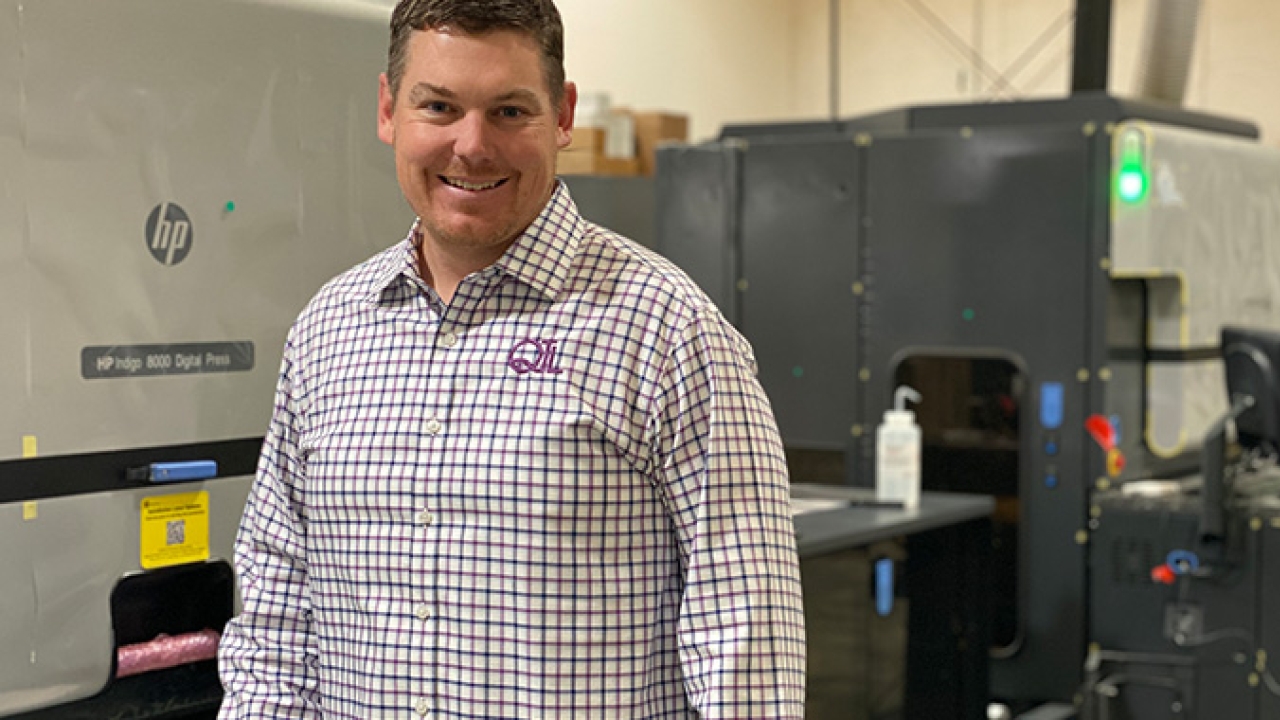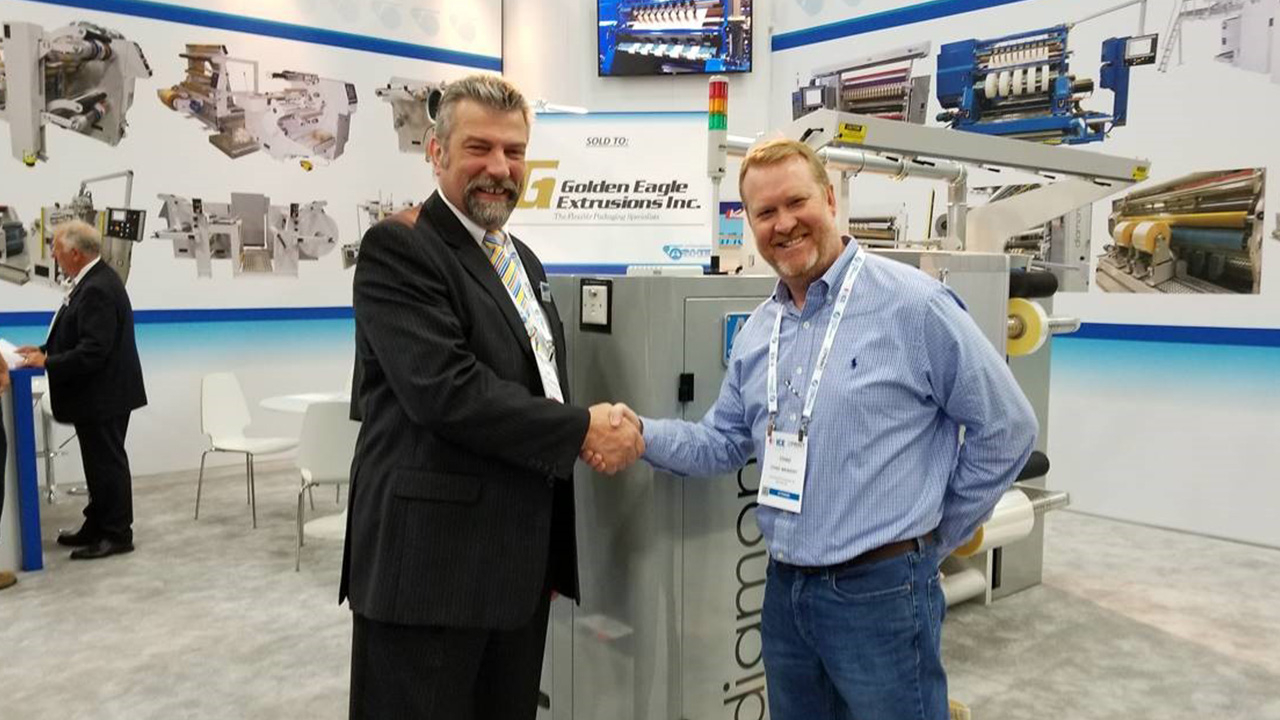Quality Tape & Label says ‘yes’ to innovation

Here’s the thing about Rob Daniels, the third-generation leader at Quality Tape & Label: He’s a ‘yes man’ in the best sense of the phrase.
There is not a job that’s too small, a project too complicated, or a cutting-edge printing technique that Daniels won’t implore his team to at least try.
Even a 30-inch bag with variable data, matte gloss, cast and cure, raised varnish and finished in a single pass. (If that wasn’t clear – Quality Tape and Label produced it.)
To put a finer point on it: QTL is easy to do business with. ‘I never want any customer to have a barrier when they’re ordering from us,’ says Daniels, the company president. ‘Our customer service is what sets us apart. We try to be easy to work with, we try to offer high-end packaging that no one else can do and at a reasonable price. We’re not the cheapest guys on the block; we’re not the most expensive either. We try to fall in that middle range and service the heck out of our customers.’
"Flexible packaging is going to overtake shrink because now we-re able to do more in-house. Now having a laminator in-house, I just cut production time by two weeks"
QTL’s production capabilities allow the company to surround its customers with complete packaging offerings, including pressure-sensitive labels, flexible packaging, shrink sleeves, wraps and folding cartons.
Quality Tape & Label’s forward thinking is proving to be a competitive advantage for the 40-year-old company, which has been on a steady growth trajectory in recent years. Today, the company has 42 employees across 2.5 shifts and annual turnover of 10.2m USD.
In late 2019, QTL moved to a 38,250 sq ft facility that triples the size of its previous headquarters and adds twice the production floor space.
When it comes to its suppliers, Daniels expects that same kind of ‘can do’ attitude that he employs at QTL. ‘We dream, we innovate, we go outside the box and we want suppliers who are the same way,’ he says. ‘We do a lot of things that are unconventional.’
Equipment
Since 2012, QTL has averaged a new machine every 12 months. The oldest piece of equipment on its production floor is a 2008 Delta ModTech converting unit.
Important to its production capabilities are QTL’s HP Indigo digital press line-up: a 6900, an 8000 and 30-inch HP Indigo 20000, and a legacy Aquafex flexo press. For converting QTL has two Delta ModTech units, a CEI machine and its newest equipment – a custom-made 30-inch Gonderflex machine for thermal laminating with flexo stations for in-line embellishments of bags and pouches coming off the HP Indigo 20000.
‘Gonderflex was the first company that said yes to me,’ Daniels says. ‘They told me they could build it, and boy, did they.’ He beams as he shows off his newest purchase. Previously, QTL sent its printed rolls to a trade shop in Chicago for laminating. Bringing these jobs in house shaves two weeks off its flexible packaging lead time.
At QTL, the front of the house technology is just as important as its production capabilities. QTL adopted pre-press workflow from Hybrid Software that is fully integrated with Label Traxx. The automation provided by Hybrid has allowed the company, which produces 94 percent of its jobs digitally, to address a growing docket of short to medium runs. The success of QTL is built largely on processing smaller orders, and it needs a workflow to power them.
With Hybrid’s Cloudflow system, QTL can change text, images, barcodes, colors and other elements linked to variable data sources, to produce a file optimized for fast printing. Cloudflow can be used to turn any PDF package or label design into a VDP design by simply indicating which elements are dynamic and linking them to the data source – without having to create a template for the label designer first. Hybrid VDP is applied at the pre-press stage, not in the pressroom, eliminating the up-front template and an online proofing tool allows QTL to send press proofs directly to the customer.
QTL was able to save time and reduce head count thanks to the level of automation. Further, it saves its valuable pre-press team from time-consuming data entry. The out-of-the-box workflow offered by Hybrid means the automation can be customized to meet QTL’s needs. ‘That’s what we found with Hybrid – everything we asked them to do, that answer was yes. Their customer service is what stands them apart.’
Are you sensing a theme yet?
Past and future
Rob is the third generation Daniels at the helm at QTL. The business that began 40 years ago by his grandparents Cecil and Myrl was then run by his father Rick, who today serves as company CEO. It was the youngest Daniels who had the vision to go after new digital markets when he joined the company in 2005.
The recent headquarters move not only gave QTL more space but will help as the company moves from traditional labels to shrink and flexible packaging. Pressure-sensitive label production accounts for 43 percent of the jobs produced at QTL, with 42 percent shrink sleeves and about 15 percent flexible packaging, though that ratio is changing.
‘Flexible packaging is going to overtake shrink as far as growth percentage because now we’re able to do more in-house,’ he says. ‘Now having a laminator in-house I just cut my production time by two weeks. It’s huge for us because we’re turning pouches around so much faster.’
QTL’s customers include food, beverage, nutraceuticals, craft beer and cannabis companies. In 2017 the company printed 450 million labels for the Share a Coke campaign. It was a high profile project for one of the largest beverage companies in the world. QTL printed customized Coke labels around the clock for four months and when it was over, hard lessons were learned.
‘I’m glad we did it, it was great exposure for us and Coke is still a great customer of ours,’ Daniels says. ‘But it opened my eyes to what I needed to do with my business. I want to stay in my lane and focus on small to medium-sized businesses and high-end packaging. Coming out of that project, we expanded our customer base and we work with more small and medium size brands that have unique opportunities to produce all kinds of packaging. With these brands, we changed the conversation from price to the value we offer. We are able to bring them to shelf faster and put more revenue in their pockets faster.’
To make this strategy successful, QTL had to work hard to build trust with a lot of small and medium brands in the hope that when they rise, they take QTL with them. Daniels talks about a customer who started ordering a couple of thousand labels here and there, and is now QTL’s biggest client. ‘They’re ordering six million sleeves a month from us. They’ve just blown up.’
QTL’s digital assets allow it to be nimble enough to respond to projects both big and small. ‘We have a customer for whom we started producing labels. Now we do their shrink sleeves and their flexible packaging. Recently they asked us to do a bundle wrap application. They came to us in a pinch and said, “I’ve got to have it done and I have to have it done right. And you’re the only guys I trust”,’ Daniels says. ‘It solidified that business. Now they see us not only as a competent printer, but now when they need something, and it has to be done right, they know to come to QTL.’
Stay up to date
Subscribe to the free Label News newsletter and receive the latest content every week. We'll never share your email address.


